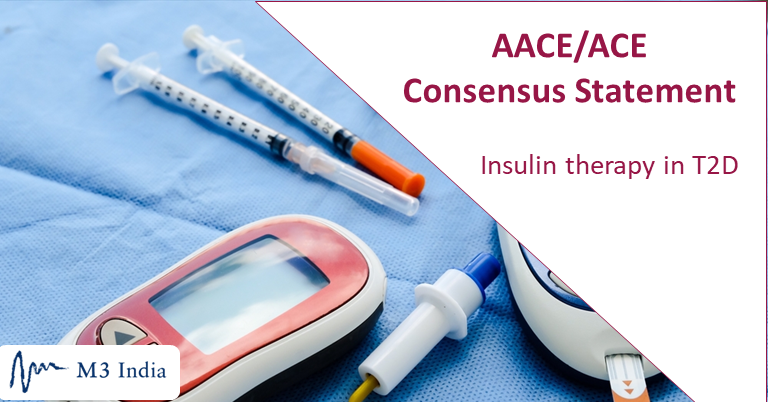Insulin therapy in type 2 diabetes: AACE/ACE Consensus Statement
M3 India Newsdesk Jun 19, 2019
The AACE and ACE consensus statement provides recommendations for:
- adopting a multifactorial approach while planning and initiating insulin therapy
- deciding and adjusting dosage for basal insulin formulations
- use of continuous glucose monitoring (CGM) in preventing hypoglycaemic events

The American Association of Clinical Endocrinologists (AACE) and American College of Endocrinology (ACE) have recently released a consensus statement outlining the comprehensive management algorithm for Type 2 diabetes, one of the main sections being glucose control with insulin. The updated 2019 document has been published in the journal Endocrine Practice.
Insulin therapy for T2D patients
The key takeaways in this section of the guidance document are:-
Planning and initiating insulin therapy
The statement mentions that while insulin is the most potent antihyperglycaemic agent, many factors should be considered when deciding to start insulin therapy and choosing the initial insulin formulation. These depend on each patient’s motivation, cardiovascular and end-organ complications, age, risk of hypoglycaemia, and overall health status, as well as cost considerations.
Patients taking two oral antihyperglycaemic agents who have an A1C >8.0% (64 mmol/mol) and/or long-standing T2D are less likely to reach their target A1C with a third oral antihyperglycaemic agent. Although adding a GLP1 receptor agonist as the third agent may successfully lower glycaemia, eventually many patients will still require insulin.
Insulin Dosage- Basal Insulin
- When insulin becomes necessary, a single daily dose of basal insulin should be added to the regimen. The dosage should be adjusted at regular and initially fairly short intervals, measured in days, to achieve the targeted glycaemic goal while avoiding hypoglycaemia.
- Basal insulin analogues are preferred over neutral protamine Hagedorn (NPH) insulin because a single basal analogue dose provides a relatively flat serum insulin concentration for 24 hours or longer. Additionally, previous clinical trials have demonstrated that compared to NPH, insulin analogs are significantly less hypoglycaemic. Accordingly, glargine U100 and detemir are favoured over NPH.
- The newest basal insulin formulations- glargine U300 and degludec U100, U200 have more prolonged and stable pharmacokinetic and pharmacodynamic characteristics than glargine U100 and detemir
- Despite higher frequency of hypoglycaemic events, in patients who require simpler regimen, premixed insulins can be used. In such cases premixed analogue insulin may be preferred over premixed human due to lower rates of hypoglycaemia.
- Patients whose basal insulin regimens (which may already include metformin) fail to provide glucose control may benefit from the addition of a GLP1 receptor agonist, SGLT2 inhibitor, or DPP4 inhibitor (if not already taking one of these agents)
- When added to insulin therapy, the incretins and SGLT2 inhibitors enhance glucose reductions and may minimise weight gain without increasing the risk of hypoglycaemia.
- Basal insulin + GLP1 receptor agonist combination offers greater efficacy than the oral agents. Depending on patient response, basal insulin dose may need to be reduced to avoid hypoglycaemia.
- In cases where glycaemia remains uncontrolled while receiving basal insulin + oral agents/GLP1 receptor agonists, mealtime insulin postprandial hyperglycaemia.
- Rapid-acting injectable insulin analogues (lispro, glulisine, aspart, or fast-acting aspart) or inhaled insulin are preferred over regular human insulin because the former have a more rapid onset and offset of action and are associated with less hypoglycaemia.
- Prandial insulin should be considered when the total daily dose of basal insulin is greater than 0.5 U/kg. Beyond this dose, the risk of hypoglycaemia increases markedly without significant benefit in reducing A1C. The simplest approach is to cover the largest meal with a prandial injection of a rapid-acting insulin analog or inhaled insulin and then add additional meal coverage later, as needed.
- A full basal-bolus program is the most effective insulin regimen and provides greater flexibility for patients with variable mealtimes and meal carbohydrate content. However, weight gain is an adverse effect with this type of a programme.
- Pramlintide is indicated for use with basal-bolus insulin regimens. Pioglitazone is indicated for use with insulin at doses of 15 and 30 mg, but this approach may aggravate weight gain.
Prevention of Hypoglycaemia
Several clinical trials found that T2D patients with a history of one or more severe hypoglycaemic events have an approximately 2- to 4-fold higher death rate. Severe hypoglycaemia may precipitate fatal ventricular arrhythmia through an effect on baroreflex sensitivity, or hypoglycaemia may be a marker for persons at higher risk of death, rather than the proximate cause of death.
- SMBG (self-monitoring of blood glucose) or CGM is necessary in all patients taking insulin, with increased frequency of monitoring recommended for patients taking meal-time insulin
- One possible safety measure for prevention of hypoglycaemia is the use of CGM that provides real-time glucose data with or without alarms for hyper- and hypoglycaemic excursions and events
-
Exclusive Write-ups & Webinars by KOLs
-
Daily Quiz by specialty
-
Paid Market Research Surveys
-
Case discussions, News & Journals' summaries